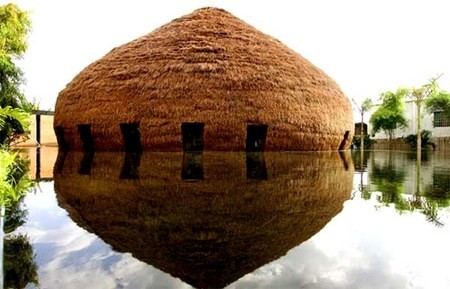However, looking to the past, it is plain to see that the traditional architecture style in Vietnam – which is observed in houses, communal houses, and temples – is a prime example of green architecture, as buildings were constructed in harmony with nature using natural and durable materials. This raises several questions. Is green architecture really a new concept? Is it different from what our ancestors did in their constructions? Will it stay with us or is it just a passing trend?
This interview with architect Vo Trong Nghia, one of the pioneers of green architecture in Vietnam, may provide readers with answers to these thought-provoking questions.
Can you tell us how you started working in green architecture?
Architect Vo Trong Nghia: When I was studying for a Master’s at Tokyo University from 2002 to 2004, my Japanese professors suggested designing constructions that are suited to local conditions – the climate and the people. Earlier, I had already found myself interested in a life in which humans live in harmony with the nature and I had thought of solutions to the issue. Moreover, when I read about Buddhist philosophy, I realised that we humans have turned our backs on the laws of nature, which can explain the root of the unhappiness of many in their material and mental lives.
So had you came up with any ideas, even primitive ones, about construction that is associated with nature, but not green architecture as we often talk about today, before you studied abroad?
Architect Vo Trong Nghia: I always recall memories of childhood. When I tended oxen with my friends, we enjoyed the fresh breeze under the shadow of large trees in the middle of the field, or when we lay down in a comfortable hammock in the forest while the spring was bubbling below. For me, nature has created spectacular architectural spaces. My childhood, which was imbued with green and beautiful natural scenes, has been incorporated into my designs.
Can it be said that green architecture is a way of designing buildings that are in harmony with nature and provide effective solutions for humans to take shelter from natural forces?
Architect Vo Trong Nghia: I could say that it is just one of hundreds or thousands of solutions, but it must be done. Green architecture is evaluated based on the criteria of energy usage and consumption. The construction may be not literally green, but once it utilises the sunlight and wind to reduce the need for manmade energy, it is an effective construction. We all know that combustible energy is not limitless and that human beings have overused and overexploited natural resources, angering nature. It is time for us to affirm that ‘architecture’ means green architecture, and green architecture is a way of life.
However, the use of artificial energy, electricity for example, also means that we have to use ever more appliances to live a more comfortable life, a goal of many people. We have not yet mentioned people’s intention of utilising land area as much as possible to increase space for their benefit. How can you balance your customers’ intentions?
Architect Vo Trong Nghia: Once customers come to our office, they already have aspirations of green architecture, so we haven’t got to do much to convince them. I consider the pressure of efficiency in the market economy as an inevitable criterion, so I just follow it. However, no matter how high your building is, you have to seek out green solutions to help save energy and limit negative impacts on the environment. The issue here is how the architect’s creativity works.
Does it seem that you are referring to your colleagues’ understanding of green architecture?
Architect Vo Trong Nghia: Personally, I think that before working with any customer, an architect should question himself first. He should clarify what his conception of green architecture is, what he will do to adapt it into the construction. Unless he answers these questions, he still has the right to refuse. I don’t want to blame others if I am not fully aware of my role and responsibilities.
In your opinion, how much do Vietnamese architects pay attention to green architecture?
Architect Vo Trong Nghia: Green architecture is no longer a new concept but it has become a certain way, like we breathe every day. I believe that in the next couple of years, there will be a huge shift in green architecture as well as in real estate projects. We can see that through the ads of real estate projects. No matter how large or small they are, the green space covers an increasing proportion of their plans. More and more customers are asking us to enlarge green space in our designs for their houses. Therefore, unless architects change their ways and promote creativity while working for green architecture, customers will turn their backs on them.
Thank you for the interview.
 |
Vo Trong Nghia was born in 1976 in Quang Binh province. He studied architecture at the Nagoya Technology Institute and the University of Tokyo, earning his MA, before returning to Vietnam to establish Vo Trong Nghia Architects company in 2006 with his Japanese partners. He has won numerous international prizes, including the Architects Regional Council of Asia (ARCASIA) gold medal in 2007 and 2011 and the 2012 Design Vanguard prize given by Architectural Record, a top American architectural magazine. In 2012, he was named Architect of the year by the Vietnam Architects’ Association, and his company was honoured as one of the top 21 architectural firms of the 21st century by World Architecture News. |
















